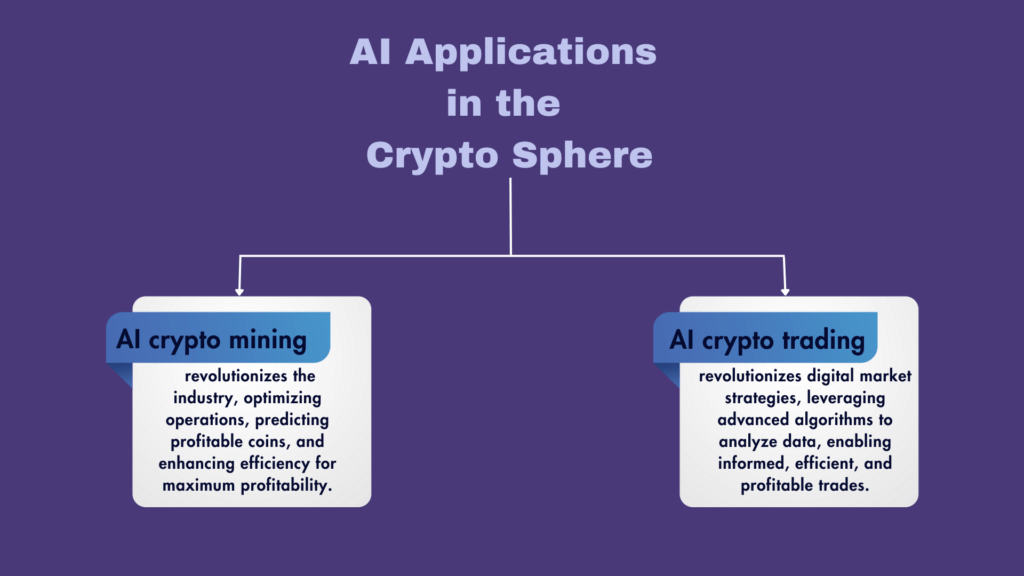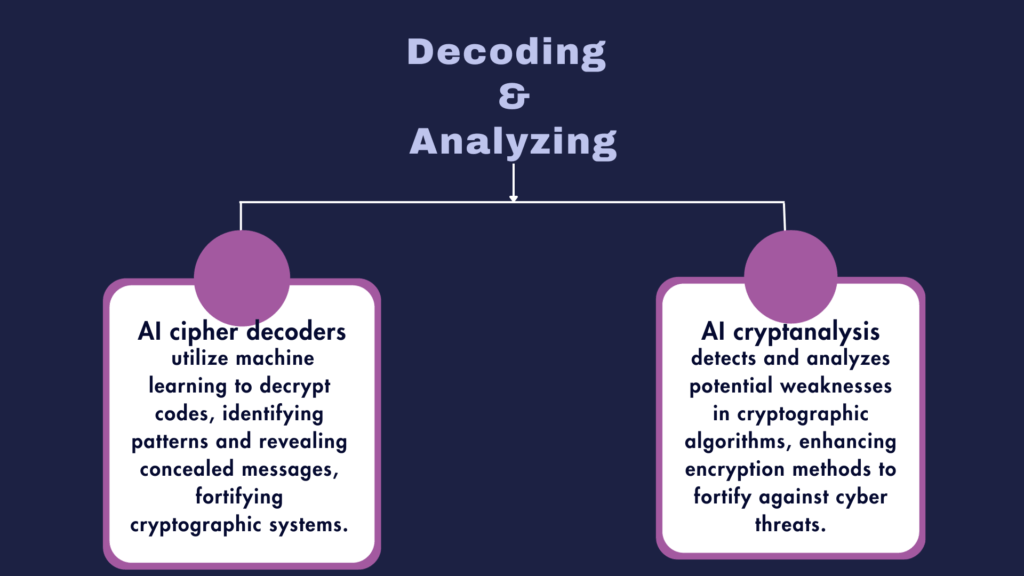Why Cryptography is used?
In the rapidly evolving digital realm of today, preserving the security of data and ensuring safe communication have taken center stage. Cryptography using artificial intelligence (AI) emerges as a state-of-the-art amalgamation, playing a pivotal role in fortifying security measures. The infusion of AI into cryptographic procedures represents an evolutionary leap, infusing innovation and flexibility into conventional encryption methods. We will explore key facets like machine learning in cryptography, machine learning crypto prediction, AI crypto mining, AI crypto trader, AI cypher decoder, and AI cryptanalysis to uncover the transformative potential they hold.
Cryptography using Artificial Intelligence
Cryptography, as a means of secure communication and data protection, has been greatly enhanced by the infusion of artificial intelligence. AI algorithms possess an unparalleled ability to process and analyze vast amounts of data swiftly. This capacity significantly enhances encryption techniques, making them more robust and adaptive. The ability of AI to discern patterns and optimize encryption methods is a fundamental advancement that holds promise for a more secure digital future.
Machine Laerning in Cryptography
Machine learning in cryptography represents a promising frontier in the realm of digital security. By integrating machine learning algorithms into cryptographic processes, we unlock the potential to significantly enhance traditional encryption techniques. With their adeptness at analyzing vast amounts of data and identifying intricate patterns, Machine Learning Algorithm, have the capacity to optimize encryption methods and make them more robust.
Machine Learning Crypto Prediction
Machine learning crypto prediction is an exciting application of AI in the domain of cryptography. In forecasting potential cryptographic vulnerabilities and weaknesses by analyzing historical data and identifying patterns Machine Learning Algorithms are very useful. This aids in the development of better cryptographic algorithms, providing an edge in fortifying encryption systems against emerging threats.
AES Cryptography and AES Cryptography Example
One of the cornerstone encryption methods is AES cryptography. AES stands out as a widely adopted and secure approach ranging from governmental communications to everyday online transactions. Operating on the principles of symmetric key encryption, AES ensures data confidentiality and integrity.
For an AES cryptography example, envision utilizing a specific key to encrypt and decrypt data. AES cryptography involves encrypting a simple text using a specific key. Let’s take the phrase “Hello, World!” and encrypt it using AES-128 (128-bit key length) with a hypothetical key “thisisakey12345.”
1.Key Expansion:
The key “thisisakey12345” is expanded and transformed to create round keys for each round of encryption.
2.Initial Round:
The input text is divided into blocks, and an initial round of AddRoundKey is performed using the initial round key derived from the original key.
3.Rounds:
The main encryption loop involves applying SubBytes (byte substitution), ShiftRows (row-wise shifting), MixColumns (column mixing), and AddRoundKey (round key XOR) operations iteratively for each round, except the last.
4.Final Round:
The final round omits the MixColumns operation and applies the AddRoundKey with the last round key.
After completing all rounds, the encrypted text is generated, which is a seemingly random string of characters. Decrypting this encrypted text requires the same key and the reverse application of the encryption steps.
It’s essential to note that the security of AES encryption heavily relies on the confidentiality and complexity of the key. Without the correct key, decrypting the encrypted text is computationally infeasible, emphasizing the importance of keeping the key secure.
AI in Crypto Sphere
AI’s integration into the cryptocurrency domain is transforming the way we mine and trade digital currencies.

AI crypto mining represents a paradigm shift in the cryptocurrency domain. Through the analysis of mining patterns, energy consumption, and market trends, AI algorithms facilitate smarter decision-making in mining operations. This includes optimizing computing resources, predicting profitable coins for mining, and dynamically adjusting strategies based on market fluctuations. Ultimately, AI-powered crypto mining aims to maximize efficiency and profitability, making it a crucial tool in the ever-evolving landscape of cryptocurrency mining.
AI crypto trading signifies a groundbreaking approach to trading in the digital currency market. By harnessing the capabilities of artificial intelligence, this cutting-edge method involves employing advanced algorithms to meticulously analyze vast amounts of market data. AI algorithms identify patterns, trends, and potential price movements, allowing for more informed trading decisions. Moreover, they can swiftly execute trades based on these analyses, aiming for optimal returns on investments. AI-powered crypto trading strives to enhance efficiency and accuracy in trading, providing traders with a valuable tool to navigate the dynamic and often volatile cryptocurrency market.
Decoding and Analyzing Cryptographic Systems with AI
The advent of AI has introduced AI cipher decoders and AI cryptanalysis as potent tools for analyzing and strengthening cryptographic systems.

AI cipher decoders apply machine learning to decode encrypted codes by learning patterns and deciphering encrypted information. Leveraging sophisticated machine learning algorithms, these decoders analyze encrypted codes by discerning intricate patterns within the data. Through this analysis, they decipher encrypted information, revealing the concealed message. The machine learning models within these AI decoders continually learn from vast datasets, enhancing their decryption capabilities over time. Thus, they play a vital role in fortifying cryptographic systems, identifying vulnerabilities, and enhancing encryption methods.
AI cryptanalysis, conversely, scrutinizes cryptographic algorithms to pinpoint possible weaknesses. This specialized field involves employing advanced artificial intelligence to dissect cryptographic algorithms and uncover potential weaknesses within them. Through a thorough analysis of these algorithms, AI identifies vulnerabilities that could potentially be exploited by adversaries. This proactive approach allows cryptographers and security experts to enhance encryption methodologies, ensuring robustness against evolving cyber threats.
Cryptography across Industries
In various sectors, cryptography serves as a bedrock for secure information exchange.
The financial sector relies on cryptography to ensure secure transactions, protecting against unauthorized access and fraudulent activities.
Cryptography is crucial in healthcare to secure patient records and sensitive medical information.
In government communications, especially concerning national security, cryptography is vital for encrypting and ensuring authorized access only.
Online security is paramount, and protocols like SSL and TLS use cryptography to create a secure environment for various online activities like shopping and banking.
Road Ahead
In the future, AI and cryptography will team up for stronger security. AI’s quick learning from threats will create encryption that adapts on the spot, making digital transactions and communications safer. In the world of cryptography, AI’s learning will predict vulnerabilities and potential attacks, letting us act proactively. As AI integrates further, these predictions will become sharper, bolstering overall security. The future will see a smart, adaptable cybersecurity approach, thanks to the blend of AI and cryptography.
We can conclude that, the synergy of cryptography and artificial intelligence holds immense promise for securing our digital world. AI, when harnessed alongside traditional cryptographic approaches, fortifies digital communication, safeguards sensitive data, and enables secure transactions across sectors. The future is exciting, with AI poised to drive the next wave of advancements, ensuring a robust and secure digital landscape for all. As technology advances, the fusion of AI and cryptography will continue to evolve, and it’s crucial that we embrace and adapt to these changes for a safer digital future.

